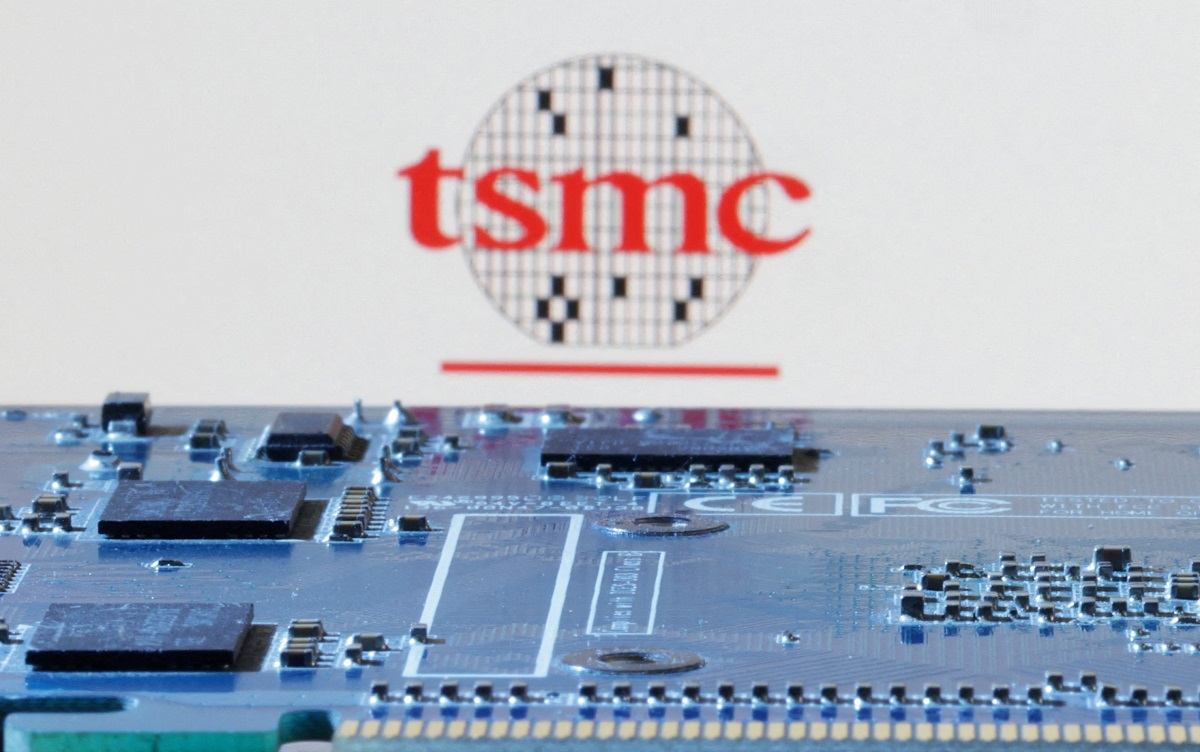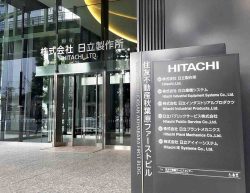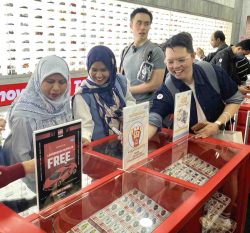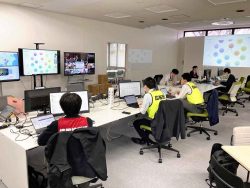Water, Electricity Helped TSMC Pick Kumamoto as Japan Base; But Semiconductor Maker May Face Labor Supply Issues

Taiwan Semiconductor Manufacturing Company (TSMC) logo is seen near computer motherboard in this illustration taken January 8, 2024.
19:44 JST, February 24, 2024
The government took the lead in attracting Taiwan Semiconductor Manufacturing Co. to build a plant in Kumamoto Prefecture, for which an opening ceremony was held Saturday. The new plant is set to start mass production by the end of this year.
On Feb. 6, the Taiwan-based contract chipmaker announced that it would build its second Japan plant in the same prefecture, aiming to complete construction by 2027. These plants will serve as important production bases from an economic security perspective, helping to ensure a stable domestic supply of semiconductors. However, the plants are faced with many issues, such as talent development.
Advanced semiconductors
A huge white plant building has arisen in the middle of quiet farmland about 5 kilometers north of Kumamoto Airport. The plant site covers 21.3 hectares. Although its opening ceremony was held Saturday, the plant will not immediately start production. However, manufacturing equipment has begun to be brought in and installed ahead of the start of mass production, scheduled sometime in the period from October to December.
The Kumamoto plant will carry out a “front-end process” of printing circuits onto silicon wafers to produce logic semiconductors, which are used to process digital data. These semiconductors, with a circuit line width of 12 to 28 nanometers, are used in cars and other products. A nanometer is one-billionth of a meter. The smaller the circuit line width, the higher the performance of logic semiconductors. At the moment, the TSMC Kumamoto plant is set to be the most advanced semiconductor plant in Japan. The second plant is expected to mass-produce 6- to 7-nanometer semiconductors to be used in artificial intelligence and smartphones.
In addition to TSMC, Sony Group Corp., Denso Corp. and Toyota Motor Corp. have decided to invest in the company operating the Kumamoto plant.
‘Silicon Island’
Semiconductors are called the “rice of industry” because they are essential to many products including personal computers, automobiles and consumer electronics. Japan depends on imports from Taiwan and the United States for many of its semiconductors. During the COVID-19 pandemic, the domestic production of automobiles and other products was suspended due to supply chain disruptions.
In order to domestically produce semiconductors, the government focused on attracting TSMC. Subsidies provided for the plants are expected to reach ¥1 trillion, including those for the second plant.
The reasons for TSMC to choose Kumamoto Prefecture include the accumulation of relevant industries, abundant water resources and a stable electricity supply.
Japan held a 50% share of the global semiconductor market in the 1980s. The Kyushu region was called “Silicon Island” and was home to many semiconductor companies. While the region has lost that momentum, more than 100 companies related to semiconductors, including major manufacturers and local companies, are concentrated in the region, creating a supply network. The region represents 40% of value of Japan’s domestic semiconductor production, making it easier for TSMC to build partnerships there.
Also, semiconductors require a huge amount of water for washing. Kumamoto Prefecture is rich in groundwater. According to the prefecture, the existing groundwater in the prefecture is estimated at 87.1 billion tons. TSMC’s first plant will take in about 8,500 tons of groundwater a day. Local people are concerned about the possible impact of TSMC’s plants on the local water supply. To address the concern, TSMC has announced that it would make efforts to preserve more water than it uses by such means as filling rice paddies with water in winter, as this contributes to groundwater preservation.
A stable electricity supply was another determining factor. A semiconductor plant operates around the clock, consuming a large amount of electricity. In the Kyushu region, four nuclear reactors are in operation and electricity rates are relatively cheap, which also encouraged TSMC to enter the region.
The biggest challenge facing the company is how to employ enough engineers and technicians.
TSMC will hire more than 3,400 workers for the two plants, including Taiwanese workers. Related companies are also entering the prefecture. In April, Kumamoto University opened its School of Informatics, specializing in semiconductors and other fields. Nine technical colleges in the Kyushu and Okinawa region have begun developing talent for the industry. The semiconductor industry involves a wide range of industries and requires diverse talent such as design and development engineers, manufacturing equipment engineers and experts capable of handling production chemicals and gases.
However, the Kyushu region is forecast to face a shortfall of about 1,000 semiconductor engineers a year over the next 10 years. When the second TSMC plant starts operations, the talent shortage could be more severe. Developing enough talent to keep up with demand will be a challenge.
"Business" POPULAR ARTICLE
-

Keidanren Chairman Yoshinobu Tsutsui Visits Kashiwazaki-Kariwa Nuclear Power Plant; Inspects New Emergency Safety System
-

Imports of Rare Earths from China Facing Delays, May Be Caused by Deterioration of Japan-China Relations
-

University of Tokyo Professor Discusses Japanese Economic Security in Interview Ahead of Forum
-

Japan Pulls out of Vietnam Nuclear Project, Complicating Hanoi’s Power Plans
-

Govt Aims to Expand NISA Program Lineup, Abolish Age Restriction
JN ACCESS RANKING
-

Keidanren Chairman Yoshinobu Tsutsui Visits Kashiwazaki-Kariwa Nuclear Power Plant; Inspects New Emergency Safety System
-

Imports of Rare Earths from China Facing Delays, May Be Caused by Deterioration of Japan-China Relations
-

University of Tokyo Professor Discusses Japanese Economic Security in Interview Ahead of Forum
-

Japan Pulls out of Vietnam Nuclear Project, Complicating Hanoi’s Power Plans
-

Govt Aims to Expand NISA Program Lineup, Abolish Age Restriction


























